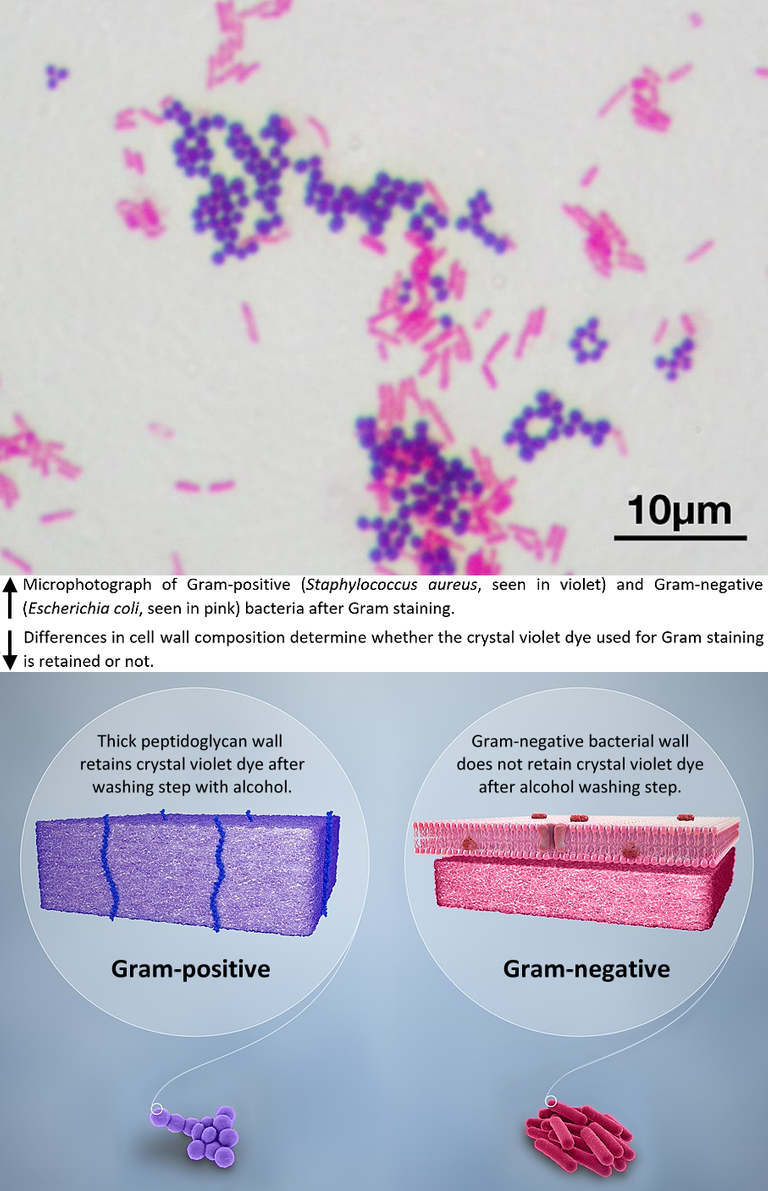Antibiotic resistance has been a growing concern in the scientific community for years. Through their use, misuse and abuse, we have slowly but surely been selecting for antibiotic-resistant bacteria. While medical professionals and animal farming have their share of the fault, to help mitigate this problem the average steemian should follow their doctor's instructions to the letter: don't stop your antibiotic treatment early because "I'm feeling better" and don't randomly pop leftover antibiotic pills because you think you are getting sick.
But I digress. To better understand the story at hand we should look at the microscopic organisms known as bacteria in more detail. Like all cells, bacteria have a cell membrane. In addition, most bacteria have their cell membrane surrounded by a cell wall whose characteristics determine whether they are designated as Gram-negative (such as the bacteria responsible for gonorrhoea, meningitis, chlamydia or pneumonia) or Gram-positive (including anthrax and staph). As seen in the image below, this classification scheme derives from their ability to retain a deep violet colour during the Gram staining test. The differential cell wall properties that can determine staining, can also determine antibiotic effectiveness. Perhaps one antibiotic will not penetrate one type of cell wall to reach its target, or perhaps another antibiotic specifically targets one type of cell wall and not the other.

If a bacterium has developed resistance to one particular antibiotic, it will probably have developed resistance to all members of the same antibiotic family to one degree or another. While multiple families of antibiotics (each targeting different bacterial subsystems) are currently available, some bacteria have evolved resistance to many of them all at once, the so-called "superbugs" you have probably heard about. Because of this, the search for novel antibiotics or antibiotic strategies has been a priority during the last few decades. Sadly, other than new variations on established antibiotics, no entirely new class of antibiotic has reached the clinic in the last 50 years to fight Gram-negative pathogens.
In a new paper published today in the Nature journal, scientists working at Genentech, Wuxi AppTec and RQx Pharmaceuticals describe a novel antibiotic class they hope could be used against so-called superbugs.
The work centred around a class of molecules known as arylomycins (extracted from Gram-positive bacteria belonging to the Streptomyces genus), which had been previously recognized for their antibiotic potential as they are capable of penetrating Gram-negative cell walls and of binding to an essential bacterial enzyme known as type I signal peptidase (SPase). The issue was that arylomycin's attack on SPase was deemed to be too weak and thought to be of limited spectrum. To counter this problem, the scientists systematically modified the original molecule to increase its capacity to penetrate Gram-negative cell walls and to bind to SPase. The end result, designated "G0775," is an arylomycin 500 times more potent than the naturally occurring original.
The new study describes how G0775 was successfully tried against several strains of "superbugs" both growing in culture plates but also infecting mice. While promising (the mice required relatively low doses of G0775), the next step is where many other exciting drugs have failed in the past: clinical trials. It's there that the new antibiotic will need to be shown to be safe for human subjects while remaining effective against infections.
Original article:
Optimized arylomycins are a new class of Gram-negative antibiotics
Further reading:
Scientists engineer a powerful new weapon against antibiotic-resistant bacteria
I think unless we can figure out a way to search&destroy specific pathogens - have little nanobot submarines gun them down, e.g. - we're gonna be locked in a never-ending arms race.
Still, I haven't been this excited with a new class since I enrolled to an all-female (bar one) ethics seminar at uni.
This post has been voted on by the steemstem curation team and voting trail.
There is more to SteemSTEM than just writing posts, check here for some more tips on being a community member. You can also join our discord here to get to know the rest of the community!
Congratulations @tychoxi! You have completed the following achievement on the Steem blockchain and have been rewarded with new badge(s) :
Click on the badge to view your Board of Honor.
If you no longer want to receive notifications, reply to this comment with the word
STOPDo not miss the last post from @steemitboard:
✅
( balance: 0 )
Hi @tychoxi!
Your post was upvoted by utopian.io in cooperation with steemstem - supporting knowledge, innovation and technological advancement on the Steem Blockchain.
Contribute to Open Source with utopian.io
Learn how to contribute on our website and join the new open source economy.
Want to chat? Join the Utopian Community on Discord https://discord.gg/h52nFrV